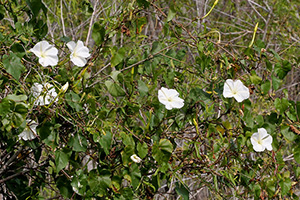Moonflower

If you want to add some mystery and nighttime ambiance to your garden, consider moonflower, which produces white blossoms that only present themselves during the night. Moonflower is a member of the morning glory family (Convolvulaceae) and is the perfect ornamental vine for climbing up outdoor structures.
Characteristics
Moonflower (Ipomoea alba), also known as tropical white morning-glory, is a native Florida vine featuring showy, white nocturnal blossoms that unfurl at dusk and close the next morning. The fragrant flowers reach up to 6 inches in diameter and open from spiraled tubular flower buds. Catching the blossoms as they unfold is witnessing nature in action—they open rapidly in just a few minutes! The flowers are pollinated by night-feeding moths such as the hummingbird moth (Hemaris spp.), which makes an audible hum like a hummingbird, hovering in front of the flower while consuming nectar.
Moonflower has twining stems with an array of large, heart-shaped, deep green leaves roughly 4 to 8 inches long. The vines usually grow up to 15 feet in height and 3 to 6 feet in width in a single season as an annual. Its native habitat includes disturbed wetland, lake edges, and mangrove fringes.
Planting and Care
With its twining growth habit, moonflower can add foliage to structures in your landscape. It does well on fences, arbors, or trellises, but can also be grown in containers such as hanging baskets. Its ability to grow quickly in the warmer months will set up your garden with established vines for the remainder of the growing season.
The plant is suitable to grow in USDA Zones 11, 10A, 10B, 9A, and 9B and does best in full sun or partial shade with moist, well-drained soils. As a low-maintenance plant, moonflower offers a unique, expansive vine with no serious pest or disease problems.
Moonflower is best propagated by seed. For the most successful germination and to weaken the seed coat, nick the seeds with a file, knife, or sandpaper or soak overnight in warm water. It’s a good idea to start the seed indoors about 6-8 weeks before the last spring frost date, then transfer the plants to their outside location 1-2 weeks after the last frost, or once the soil warms up in the spring. You can also plant the seeds directly in the ground after the last frost instead of starting inside, but flower blooms will be delayed to later in the summer.
Generally, moonflower blooms occur from late July into fall. Around October or when the weather cools, moonflower will begin setting and ripening its seeds, marking the end of the blooming stage. You can collect the mature seed pods and air dry them to remove the seeds for future use. It is recommended to keep the seeds at room temperature in a storage bin like a plastic container. After collecting the seeds in the fall, allow the plant to die back in the winter and then you can replant in the spring.

Moonflower is an intriguing low-maintenance vine with alluring blossoms, adding pops of white in the night. To add this plant to your home garden, seeds can be found at hardware, home improvement, and garden stores.
